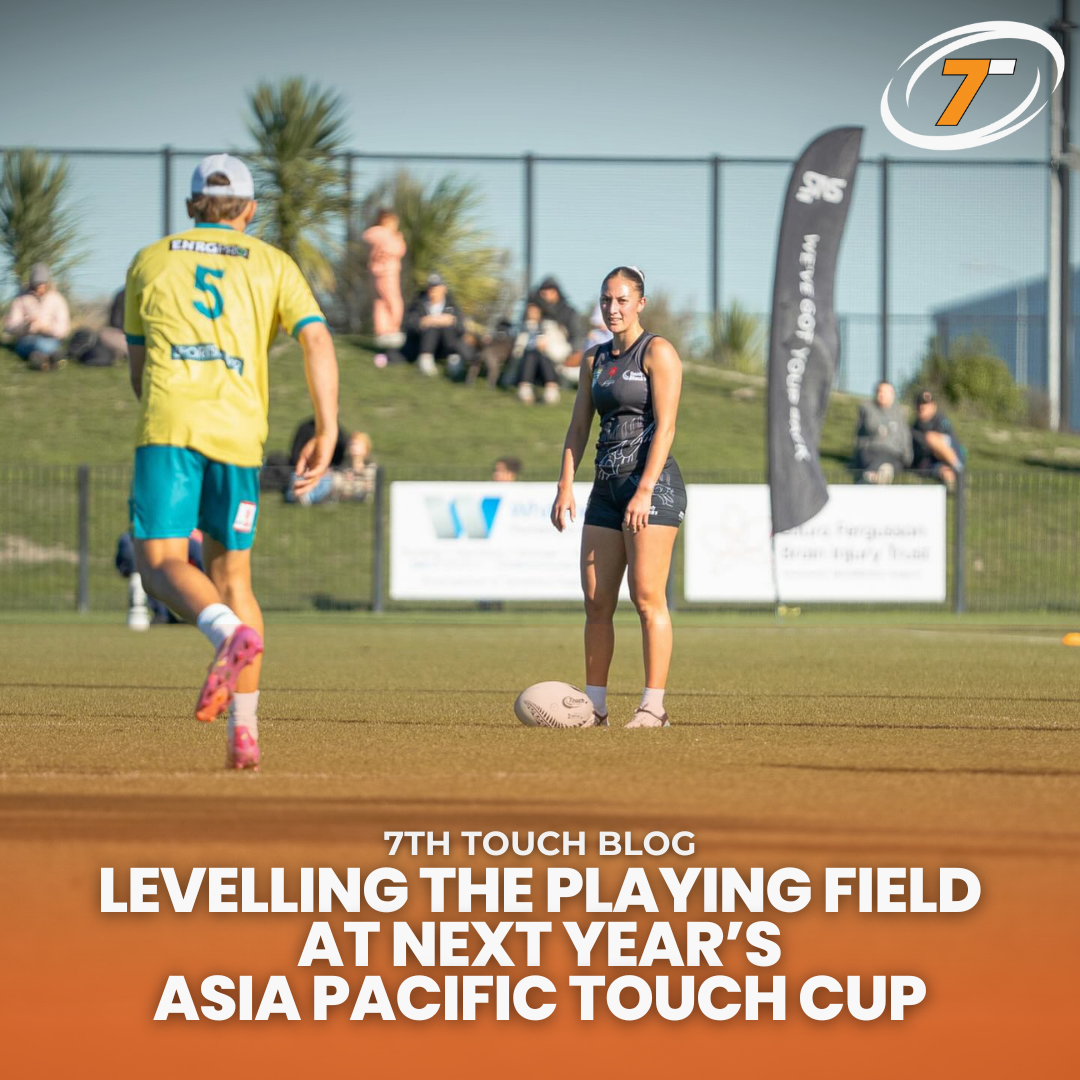Over the last few months, the Federation of International Touch (FIT) has announced the confirmation of two major inter-national tournaments for Oceania and Asia for 2026. The Asia Pacific Opens Touch Cup is scheduled to take place in Redcliffe, QLD in April 2026 while the Asia Pacific Seniors Touch Cup will head to Utsunomiya, Japan — the first multi-nation event hosted in the country since the 2003 Touch World Cup.
A lot of nations are excited about the prospect of playing international opponents outside of a World Cup year, and rightly so. But it’s hard not to look past the default script. You know the one. Australia and New Zealand will beat almost every other nation by 10 and meet in all three finals while the rest of the nations will be slogging it out for bronze.
Arrogant? Probably. Harsh? Perhaps. Does anyone want to see it happen? Absolutely not. But to show how realistic that could potentially be at next year’s tournaments, let’s look at some statistics from last year’s Touch World Cup in Nottingham. Across all 13 grades, Australia and New Zealand played 56 games against other Asian and Pacific nations. In those 56 fixtures, they collectively scored an astonishing 891 tries while having only 94 scored against them — an average scoreline of 16-2. The closest any nation came to beating either of the two Trans Tasman rivals was Japan’s valiant 7-2 loss to Australia in the Women’s Open grade. Pretty lopsided, right?

Japan's Women's Open came the closest to toppling an Australian or New Zealand team at last year's Touch World Cup in Nottingham, going down to the Emus 7-2.
Now, this isn’t to discourage any nation looking to compete. But at this point, that’s what we’re facing at those tournaments and we all know that that wouldn’t be a good look for the game. An outcome like that does nothing for our sport. And it’s not like it’s anyone’s fault, it’s just unfortunate that the two best nations in the world will be competing.
There needs to be some effort to level the playing field as much as possible to ensure the best on-field product is on display. Here’s three ways we can do that:
Option A: Keep Australia and New Zealand out of the Asia Pacific Cups, but on-hand to stage a Trans Tasman series.
Admittedly, this isn’t the favoured option, but let’s face it: without the Emus and Touch Blacks there to waltz through to a predictable final, the Asia Pacific Cup becomes more open, unpredictable and competitive while also giving the other nations centre stage to showcase their talent.
The Emus and Touch Blacks could still be there, fitting their annual three-test series in and, seeing as they’ll be there anyway, you could absolutely organise a few exhibition matches against countries that would be present. This would give select nations the opportunity to play against the cream of the crop without having any bearing on their standing in the Asia Pacific Cup tournament itself.
There are a few downsides to this concept, one of which being a perceived devaluing of the tournament itself if it doesn't officially include the top two nations in the world — it would essentially be considered a B-grade competition. It also runs on the presumption that there would be enough team entries to fill the grades on offer. If certain grades have a low number of team entries, this option simply won't work. Finally, barring countries from competing in a tournament they have every right to play in flirts with the idea of discrimination and exclusion, something that wouldn't be a great look for the game.

One format keeps the spectacle of a Trans Tasman, but separates the series from the actual Asia Pacific event.
Option B: Change the competition format from a tournament-style to an international series.
Rather than host the Asia Pacific Touch Cup as a tournament-type competition, turn it into an international series. There are plenty of nations that are organising bilateral competitions already in 2026. Australia and NZ played a Trans Tasman in April, Singapore hosted Hong Kong in a three-match series across multiple grades last month, and the Cook Islands and Lebanon are slated to do the same this coming week in Sydney’s west. Why not have all of those series in one place at the same event?

Tonga upset reigning bronze medallists Japan at the 2024 Touch World Cup during pool play. Could they do the same over a three-test series?
The competition could also see each nation play 3-5 standalone one-off tests against other nations in addition to their three-test series. If you look at the results at last year's World Cup between those other Asia-Pacific nations, it was close to dead even. Japan, Cook Islands, Lebanon, Papua New Guinea, Tonga, Singapore, Samoa, Malaysia, Fiji, Philippines and Hong Kong all snatched wins against each other across all grades. Staging the event as an international series gives each nation a competitive opponent where the overall result is unpredictable, and a matchup against one of the Tier 1 powerhouses doesn't affect their overall standing as it would in a tournament format. A comfortable two games per day in a Thursday-Sunday event could see nations play up to eight tests across the series while removing the expected Australia/New Zealand dominance.
The general consensus could be disagree with this format due to there not being enough competition. A three-test series may be an OK concept in theory, but nations might want the opportunity to test themselves in a tournament arena against the best in the world, and the pressure that comes along with it. A win from an underdog in a tournament format that could knock one of those top two nations off their perch and out of a tournament? You'd only need to look as far as the inaugural Asia Pacific Youth Touch Cup in 2023, when Philippines upset New Zealand in the U20 Mixed grade, to see the excitement of that and what that can do for a tournament's legacy. An international series would rob nations and spectators any chance of something like that happening.

A three-test series format would take away meaningful upsets such as the Philippines' semi final victory over New Zealand in the U20 Mixed grade at the 2023 APYTC.
Option C: Stage a Trans Tasman before the Asia Pacific Cup
Staging a Trans Tasman series before the Asia Pacific event could have some benefits for all nations. A Thursday-Sunday time slot, for example, could see the Trans Tasman series wrapped up by Friday afternoon, followed by the tap off of the regional event by Friday evening and continuing through the weekend. A format like this allows for a comfortable 2-3 games per day schedule while also turning the Trans Tasman into a dual-purpose showpiece — great for viewers and spectators, and invaluable for visiting nations who get to watch, analyse and test themselves against the best across multiple days.

Levelling the playing field in the Senior divisions becomes difficult with a traditionally lower player base and team entries for international events.
What makes this option remotely attractive for other nations competing? Well, Touch Football Australia and Touch New Zealand could lean into this format by carrying extended squads of 20-25 players to the tournament, selecting their best lineup for the Trans Tasman and then embracing the challenge of trialling combinations, blooding young talent, and building depth through the Asia Pacific Cup against the other nations. For other participating nations, it also offers a slightly better competitive balance where instead of playing against Australia or NZ’s top 14 players, they would instead play against a mix of frontline players and wider squad members. Australia and New Zealand get to introduce up-and-coming talent to international competition while Asian and Pacific nations get to face a diluted, yet still highly competitive opposition. It’s a mutually beneficial long-term play aimed at really closing the gap between the Trans Tasman rivals and the rest of the world.
Admittedly, this option would be difficult to monitor logistically particularly when it comes to separating the two tournaments, and, realistically, it would probably only work at the Opens level due to the lower number of participants that tend to enter the Seniors grades. Plus, it would require complete buy-in from the Emus' and Touch Blacks' camps — something that could be near-impossible due to the fierce rivalry between the two. Any sniff of an upper hand, and both nations are likely to take advantage of it.

After impressive showings at last year's Touch World Cup, Lebanon and Cook Islands would be frontrunners to cause an upset at Opens level.
At the end of the day, the goal leading into the tournament should be around levelling the playing field as much as possible. The Trans Tasman rivals are without a doubt the best in the world currently, and have been for a long time, while for every other nation it has been about the race for bronze. The inaugural Asia Pacific Cup could draw a line in the sand for future editions of the tournament, but what side of that line it sits on is going to tell the true tale. Is it going to meaningfully develop Touch internationally for the Asia-Pacific region? Or is it simply going to be used to add another trophy in the cabinet for the Trans Tasman neighbours?

